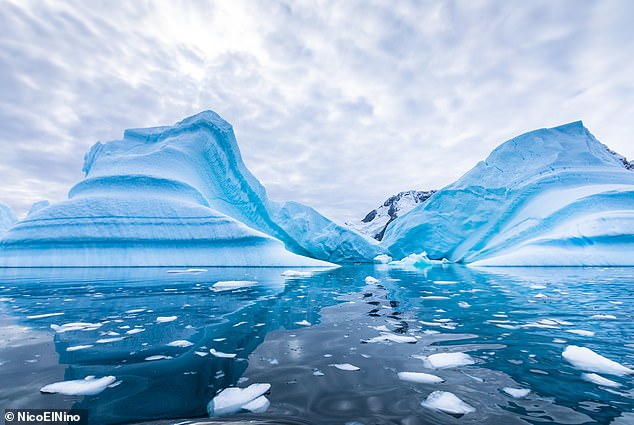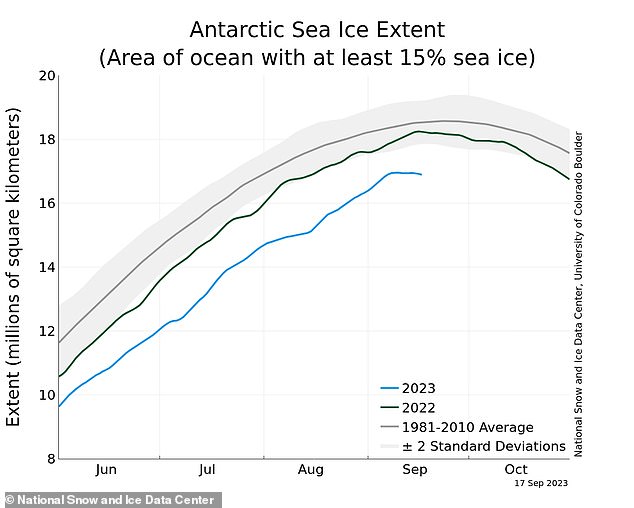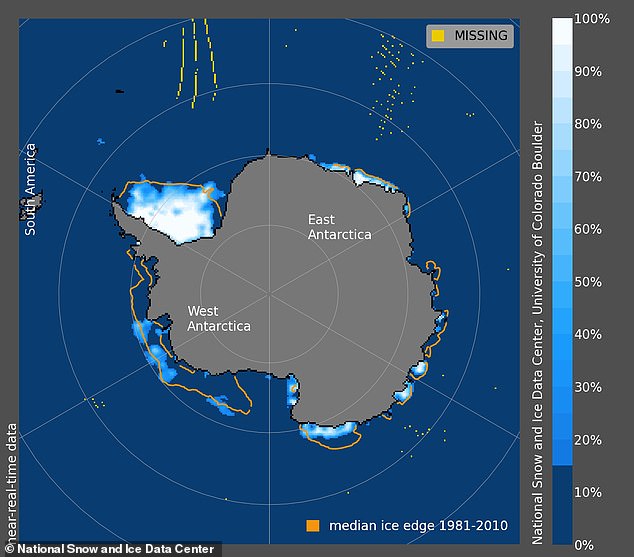Antarctic sea ice levels are at a ‘staggering’ historic low – with an area five times the size of the British Isles missing ice, research shows
>
Sea ice levels in Antarctica are at a ‘stunning’ all-time low for winter, scientists have revealed.
According to the US National Snow and Ice Data Center, the ice surrounding Earth’s southernmost continent now measures less than 17 million square kilometers.
This is 580,000 square miles (1.5 million square kilometers) less than the September average – and equivalent to five times the size of the British Isles.
Researchers have already revealed that ice in Antarctica during this year’s Southern Hemisphere summer was the lowest on record.
Less sea ice can threaten the habitats of penguins, seals and other Antarctic wildlife, and also contributes to global sea level rise.
Sea ice levels in Antarctica are at a “staggering” historic low for the winter, scientists at the National Snow and Ice Data Center have revealed. The graph shows the current sea ice area compared to the average for this time of year
“It’s so far beyond anything we’ve ever seen, it’s almost astonishing,” Walter Meier, senior research scientist at the National Snow and Ice Data Center, told me. the BBC.
Antarctica, the world’s southernmost continent, is an ice-covered landmass in the Southern Ocean (also known as the Antarctic Ocean).
Although Antarctica is a landmass, the seawater surrounding the continent is also frozen, making the continent appear larger than it actually is.
This sea ice extends from the far north in winter and retreats almost to the coastline each summer as temperatures rise and fall.
The amount of ice surrounding Antarctica is known as ‘sea ice extent’.
Climate scientists continuously monitor the extent of sea ice through the seasons and compare its extent to the same months of previous years to see how it changes.
They think Antarctica’s sea ice is crucial because the ice reflects light from the sun, keeping the polar regions cool.
Without this ice cover, dark parts of the ocean are instead exposed, which absorb sunlight instead of reflecting it, which in turn warms the region and further accelerates ice loss.

As in the Arctic, the ocean surface around Antarctica freezes in winter and melts back each summer. Antarctic sea ice (photo) usually reaches its annual maximum extent in mid- to late September, and reaches its annual minimum in late February or early March
Melting ice is, of course, contributing to sea level rise, which scientists fear will flood major cities around the world within this century.
Antarctic sea ice normally reaches an annual maximum around this time of year (winter in the Southern Hemisphere) due to frigid temperatures and nearly 24 hours of darkness.
Meanwhile, in the Southern Hemisphere winter (December to February) there is a minimum of Antarctic sea ice – also known as the ‘melt season’.
Data from the National Snow and Ice Data Center recently showed that sea ice extent is lower than average since records began, regardless of time of year.
It showed that there were only 1.91 million square kilometers of ice around the continent in February – the lowest since records began.
It is widely believed that the decline in sea ice extent is mainly caused by the greenhouse gas effect, which is fueled by the burning of fossil fuels such as coal and gas.
However, sea ice extent is also affected by wind and ocean currents and by temperature, so there is a chance that there are other factors besides global warming.
But according to one expert, the cause of the decline in sea ice extent is not as important as the decline itself.

Data from the National Snow and Ice Data Center recently showed that sea ice extent is lower than average since records began, regardless of time of year

In February, data from the National Snow and Ice Data Center revealed that there are only 737,000 square miles (1.91 million square kilometers) of sea ice around Antarctica. The photo shows the concentration of sea ice in Antarctica on February 13, 2022
‘The bottom line is that we don’t know for sure the cause – the Antarctic system is complex and poorly sampled,’ Professor Martin Siegert, a glaciologist at the University of Exeter, told MailOnline.
‘It would be good to have a definitive answer to that, but it doesn’t really matter.
“We certainly can’t afford to attribute this to variability as an excuse not to stop burning fossil fuels – that would be insane.”
The rapid warming has already led to a significant southward shift and contraction in the distribution of Antarctic krill – a keystone species, campaigners say.
A recent Greenpeace expedition to Antarctica also confirmed that gentoo penguins are breeding further south due to the climate crisis.
